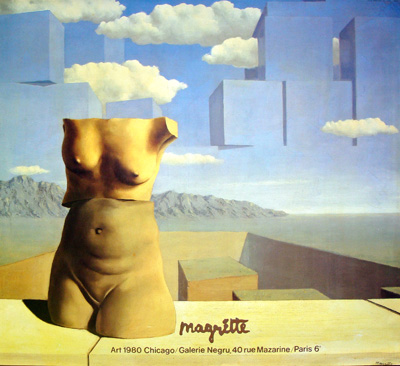Tokyo Akazukin and the Dark Side of Surrealism (nsfw)
Recently I started to read the 4-vol. manga Tokyo Akazukin (by Benkyo Tamaoki), because of two posts by bloggers digiboy (Yes, I am Going to Hell for This.) and omisyth (Two Reasons NOT to Read Tokyo Akazukin). With teasers like that I just had to pick this up! The protagonist is an 11 year-old immortal seeking the one being that can destroy her, a so-called Mr. Wolf.

the mad Tokyo Red Hood
Initially the first thing that caught my attention was the manga covers: the heroine looks more like a heroin addict (Dakota Fanning in a couple of years), as if an overworked child star were doing a Little Red Riding Hood film and the makeup artist had called in sick that day.
Anyway, this is hardcore eroguro with lolis thrown in, and for the first two volumes there’s not much of a plot. I had read that the story would get going in the third volume so I was trying to finish the second volume quickly when all of a sudden I came across this:

lurking inside a creepy house...
I had just seen that same sort of doll twice in the last month or so. The first was in a “History of Photography” book and the second was in a book called Exquisite Corpse: Surrealism and the Black Dahlia Murder. Look here:

one of the myriad Bellmer dolls
Black Dahlia was the nickname given to an aspiring Hollywood starlet named Elizabeth Short, who was found dead in 1947 in very creepy circumstances. She had been cut in half, all the blood had been drained from her body, and several bits of flesh were cut out including a breast. She had been left on the grass as if on display. The case has never been solved, but the book I read focused on one of the suspects in the case, doctor George Hodel, who was extremely invoved in the art scene in California throughout his life. The authors believe he was trying to create a Surrealist masterpiece out of a real human being and the book gives a ton of circumstantial evidence on the resemblances between the murder and Surrealism. Incidentally, Hodel was accused by his daughter of incest and acquitted in court.
Hans Bellmer was a photographer/artist in the Surrealist movement and several of his dolls appear in the Black Dahlia book. Bellmer dolls were a formative influence on artist Mitsukazu Mihara , who is something like a Popess of Gothlolidom, so the Akazukin manga is in good company in using them.
Bellmer is also a good example of how Surrealists were fond of manipulating and dissecting female bodies in their work. Cutting the body in parts was very popular. For example, Magritte does it here, subtly:

Rene Magritte's "The Marches of Summer"
After I saw what looked so much like a Bellmer doll in the manga, I was reminded of a scene just a couple of chapters before. Here it is:

down (actually, up) but not out
A hired assassin has cut Akazukin’s torso in half. Now, Magritte’s painting above doesn’t look much like the Akazukin scene, sure. There’s another pic, though, that does resemble it. It’s a photo by Man Ray. Man Ray was a Surrealist photographer and a good friend of George Hodel–I have even seen it suggested on the net that Man Ray helped Hodel out in the murder. In any case, it’s argued that this photo is the key to the arrangement of the Black Dahlia’s corpse. Here:

Man Ray's "The Minotaur"
I think that the composition of black and white in this minotaur and in the severed Akazukin scene are similar. The fact that Akazukin’s hands are tied up reminds one of the raised arms of the minotaur. Man Ray’s idea was to make the model’s stomach into the minotaur’s mouth (nipples = eyes, arms = horns). The body of Elizabeth Short was cut just around the same area as the bottom of Man Ray’s photo (in a sense, the model in the photo has been cut too, right?)
So I kept on reading about poor Akazukin and soon enough (all of the scenes in this post are taken from chapters 6-8, vol. 2) she was tied up again, like this:

One breast is missing just as in the case of the Black Dahlia (I imagine you can find images of the crime scene online, I’d rather not post pictures of corpses on my blog). Surprise, surprise, the missing breast is somewhat common in Surrealism. For example, here both breasts are missing, rather abstractly:

"Exquisite Corpse" by Andre Breton & co
There are a couple of critical differences between Surrealism and the imagery of Tokyo Akazukin. Blood and guts are all over the place in the manga, whereas Surrealist models tend to be lifeless Bodies without Organs (Man Ray is an exception in my opinion, his work is often quite raw) . In the Black Dahlia murder, as in a good Surrealist painting, the victim was bloodless and the body consequently ivory white; even the organs had been tucked in into their respective sides of the cut torso. The other difference is that whereas in Surrealism the female bodies are powerless against the artist (those Bellmer dolls), Akazukin and her mates come back and destroy their enemies with a vengeance.
You can argue that Surrealism is extremely chauvinistic: that it’s basically a bunch of men obsessed with dreams of women they can control, manage, dispose of. I certainly get that sense from seeing photos of Salvador Dali arranging his nude models. Here:

genius: yes; feminist: no
But Tokyo Akazukin’s differences from Surrealism do not make at any closer to a feminist art. The heroine is still trapped in a dream created by men and the sexploitation continues. Or maybe in this late capitalist stage male artists have grown so weary of life that they fantasize about death: preferably at the hands, and after having had super kinky sex with, girls.
Now after writing this I’ll get to finish volume two and get on to the plot! Also, I want to pre-emptively apologize to Dakota, just in case…
LINGUISTIC NOTE: There’s something interesting about the name Akazukin (赤ずきん). [aka = red] and [zukin = hood] and this is the classic translation for Little Red Riding Hood in Japan. It’s a funny compound because “aka” is written with its kanji (赤), but the word “zukin” is spelled in hiragana instead of its own characters (=頭巾). The “kin” character is not on the official Japanese government list and so it makes perfect sense, especially in the context of children’s literature, to write “zukin” in the easier hiragana. But the wacky thing is that the word “zukin” can also mean “intense, throbbing pain” so the term “akazukin” (written with “zukin” in hiragana) can easily mean “red throbbing pain”, which goes all too well with the storyline in the manga…




That first manga screencap definitely feels surreal. Can’t say the same for the other two for the reasons you’ve already mentioned. Anyway, very interesting look at surrealism.
Extremely amazing post, here, bud, this is stuff I love to read and you’ve done amazing research. I’m glad to have this kind of thing to look at in one of my favorite manga, and maybe feel less bad about loving it (it’s art dammit!)
As for whether or not it’s feminist, I actually think it may be. Tokyo Akazukin is written a lot like the stories I write – the girl is the all powerful. She the men are weaker than her because they think they can rape or kill her, but such things don’t even affect her. She can’t even die. In my stories, often a young girl has a troubled past and comes back to end up the most badass motherfucker alive and when everyone else is dying, she lives forever. I also always write lesbians, and Akazukin could be argued to be at least a little in love with the four-armed girl.
I’ve always thought of my style as ‘anti-feminist feminism’ so maybe that’s Akazukin. Or maybe it’s just horny and perverse and I’m trying to justify it.
Thanks, digiboy, I can’t get into your head to say for sure, but I imagine there might be more of the perverse than the feminist in ya 🙂 I’ll be looking forward to future recommendations!
gaguri, this dark side to surrealism is definitely very interesting. one of the surrealists said: “if they knew what we were thinking, they’d lock us up”. So it goes well with the dark side of anime..
So, I read Tokyo Akazukin, intrigued. I came away from it, still intrigued. I didn’t like it nearly as much as I like Franken Fran, but I did like it. And I finally had something to listen to the Manson Family while reading… complements eachother well, them two.
I find it fascinating how this kind of art (urrr I’ll call it that in light of your post anyway) can find an audience and a following… Apart from Guro, we have for example de Sade, Pasolinis Saló (based on de Sades magnum opus), Chuck Palanhuik and other transgressive authors. Not exactly mainstream shizz, but still with their decent cult followings. While I suppose some people actually do want to realize those bloody phantasmagoria in real life, I doubt a sizeable, at all remotely significant part of the fanbase (lol, talking as if this had a large following) does. So is it the exoticity? Psychological masochism? Thrill of the forbidden? Or what? hmm
idea for a post is born.
Anyway, cheers for yet another winsome recommendation post. Cheers to digitalboy too.
I like this analysis on Tokyo Akazukin, since it brings another aspect into the manga which is more than LOL SHOCK FACTOR MANGA. I feel like I need to give it a little read again to understand the story, since it seemed not too cohesive in my first and only run through. That and the whole religious symbolism of it all.
TheBigN, I’m just into volume 3 with all of its complex plot (the selection of the name of Astarte is nice, there’s one hawt neglected goddess for you!). Kaiserpingvin, I’ll be awaiting your eroguro fantasy post (I’m already on the Franken Fran too). Sade is cool but gets monotonous after awhile..
[…] Tokyo Akazukin and the Dark Side of Surrealism (nsfw) […]
[…] [this] and [this] and [this] and [this] and [this], oh, and let’s throw in a little bit of [this] for good measure. IF FEMALE NUDITY OFFENDS YOU SKIP THESE […]
where can i read this